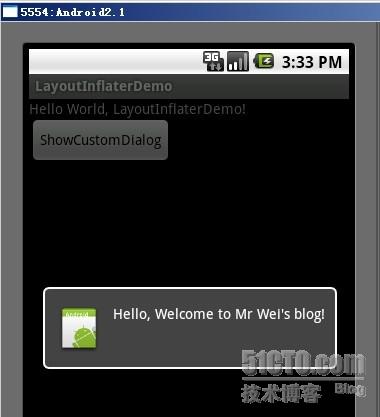LayoutInflater的使用,在实际开发种LayoutInflater这个类还是非常有用的,它的作用类似于 findViewById(),不同点是:
LayoutInflater是用来找layout下xml布局文件,并且实例化!
findViewById()是找具体xml下的具体 widget控件(如:Button,TextView等)。
为了让大家容易理解我做了一个简单的Demo,主布局main.xml里有一个TextView和一个Button,当点击Button,出现 Dialog,而这个Dialog的布局方式是我们在layout目录下定义的custom_dialog.xml文件(里面左右分布,左边 ImageView,右边TextView)。
效果图如下:

下面我将详细的说明Demo的实现过程:
1、新建一个 Android工程,我们命名为LayoutInflaterDemo.
2、修改main.xml布局,里面主要在原来基础上增加了一个Button.代码如下:
< LinearLayout
xmlns:android = " http://schemas.android.com/apk/res/android "
android:orientation = " vertical "
android:layout_width = " fill_parent "
android:layout_height = " fill_parent "
>
< TextView
android:layout_width = " fill_parent "
android:layout_height = " wrap_content "
android:text = " @string/hello "
/>
< Button
android:id = " @+id/button "
android:layout_width = " wrap_content "
android:layout_height = " wrap_content "
android:text = " ShowCustomDialog "
/>
</ LinearLayout >
3.定义对话框的布局方式,我们在layout目录下,新建一个名为 custom_dialog.xml文件具体代码如下:
< LinearLayout
xmlns:android = " http://schemas.android.com/apk/res/android "
android:orientation = " horizontal "
android:layout_width = " fill_parent "
android:layout_height = " fill_parent "
android:padding = " 10dp "
>
< ImageView android:id = " @+id/image "
android:layout_width = " wrap_content "
android:layout_height = " fill_parent "
android:layout_marginRight = " 10dp "
/>
< TextView android:id = " @+id/text "
android:layout_width = " wrap_content "
android:layout_height = " fill_parent "
android:textColor = " #FFF "
/>
</ LinearLayout >
import android.app.Activity;
import android.app.AlertDialog;
import android.content.Context;
import android.os.Bundle;
import android.view.LayoutInflater;
import android.view.View;
import android.view.View.OnClickListener;
import android.widget.Button;
import android.widget.ImageView;
import android.widget.TextView;
public class LayoutInflaterDemo extends Activity implements OnClickListener {
private Button button;
public void onCreate(Bundle savedInstanceState) {
super .onCreate(savedInstanceState);
setContentView(R.layout.main);
button = (Button)findViewById(R.id.button);
button.setOnClickListener( this );
}
@Override
public void onClick(View v) {
showCustomDialog();
}
public void showCustomDialog()
{
AlertDialog.Builder builder;
AlertDialog alertDialog;
Context mContext = LayoutInflaterDemo. this ;
// 下面俩种方法都可以
LayoutInflater inflater = getLayoutInflater();
LayoutInflater inflater = (LayoutInflater)mContext.getSystemService(LAYOUT_INFLATER_SERVICE);
TextView text = (TextView) layout.findViewById(R.id.text);
text.setText( " Hello, Welcome to Mr Wei's blog! " );
ImageView image = (ImageView) layout.findViewById(R.id.image);
image.setImageResource(R.drawable.icon);
builder = new AlertDialog.Builder(mContext);
builder.setView(layout);
alertDialog = builder.create();
alertDialog.show();
}
}
摘录自:http://weizhulin.blog.51cto.com/1556324/311450
补充总结:
1.一般来讲,我们用LayoutInflater做一件事:inflate。inflate这个方法总共有四种形式,目的都是把xml表述的layout转化为View。(This class is used to instantiate layout XML file into its corresponding View objects . It is never be used directly -- use getLayoutInflater() or getSystemService(String)getLayoutInflater() or getSystemService(String) to retrieve a standard LayoutInflater instance that is already hooked up to the current context and correctly configured for the device you are running on)
2.获得LayoutInflater的方法:
1)通过SystemService获得
LayoutInflater inflater=(LayoutInflater)context.getSystemService(Context.LAYOUT_INFLATER_SERVICE);
2)从给定的context中获得
LayoutInflater inflater = LayoutInflater.from(context);
两者区别:实质是一样的,看方法(2)源码

 code
code
LayoutInflater LayoutInflater =
(LayoutInflater) context.getSystemService(Context.LAYOUT_INFLATER_SERVICE);
if (LayoutInflater == null ) {
throw new AssertionError( " LayoutInflater not found. " );
}
return LayoutInflater;
}
3.LayoutInflater.inflate()
将Layout文件转换为View,顾名思义,专门供Layout使用的Inflater。虽然Layout也是View的子类,但在android中如果想将xml中的Layout转换为View放入.java代码中操作,只能通过Inflater,而不能通过findViewById(),这一段描述有误,看如下代码 。看下面文档写的已经很清楚。

 .placeslist_linearlayout.xml
.placeslist_linearlayout.xml
android:orientation="vertical"
android:layout_width="fill_parent"
android:layout_height="wrap_content">
<LinearLayout android:id="@+id/placeslist_linearlayout"
android:layout_width="fill_parent"
android:layout_height="wrap_content"
android:orientation="vertical">
</LinearLayout>
</ScrollView>
LinearLayout linearLayout = (LinearLayout) findViewById(R.id.placeslist_linearlayout);
linearLayout.addView(place_type_text);
这是可运行的,这上面的xml中,LinearLayout不再是Layout的代表,而只是一个普通的View。




















 62
62











 被折叠的 条评论
为什么被折叠?
被折叠的 条评论
为什么被折叠?








